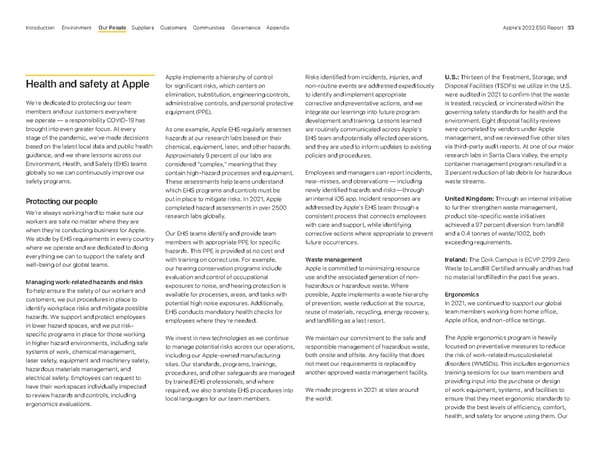Health and safety at Apple We’re dedicated to protecting our team members and our customers everywhere we operate — a responsibility COVID-19 has brought into even greater focus. At every stage of the pandemic, we’ve made decisions based on the latest local data and public health guidance, and we share lessons across our Environment, Health, and Safety (EHS) teams globally so we can continuously improve our safety programs. Protecting our people We’re always working hard to make sure our workers are safe no matter where they are when they’re conducting business for Apple. We abide by EHS requirements in every country where we operate and are dedicated to doing everything we can to support the safety and well-being of our global teams. Managing work-related hazards and risks To help ensure the safety of our workers and customers, we put procedures in place to identify workplace risks and mitigate possible hazards. We support and protect employees in lower hazard spaces, and we put risk- specific programs in place for those working in higher hazard environments, including safe systems of work, chemical management, laser safety, equipment and machinery safety, hazardous materials management, and electrical safety. Employees can request to have their workspaces individually inspected to review hazards and controls, including ergonomics evaluations. Apple implements a hierarchy of control for significant risks, which centers on elimination, substitution, engineering controls, administrative controls, and personal protective equipment (PPE). As one example, Apple EHS regularly assesses hazards at our research labs based on their chemical, equipment, laser, and other hazards. Approximately 9 percent of our labs are considered “complex,” meaning that they contain high-hazard processes and equipment. These assessments help teams understand which EHS programs and controls must be put in place to mitigate risks. In 2021, Apple completed hazard assessments in over 2500 research labs globally. Our EHS teams identify and provide team members with appropriate PPE for specific hazards. This PPE is provided at no cost and with training on correct use. For example, our hearing conservation programs include evaluation and control of occupational exposures to noise, and hearing protection is available for processes, areas, and tasks with potential high noise exposures. Additionally, EHS conducts mandatory health checks for employees where they’re needed. We invest in new technologies as we continue to manage potential risks across our operations, including our Apple-owned manufacturing sites. Our standards, programs, trainings, procedures, and other safeguards are managed by trained EHS professionals, and where required, we also translate EHS procedures into local languages for our team members. Risks identified from incidents, injuries, and non-routine events are addressed expeditiously to identify and implement appropriate corrective and preventative actions, and we integrate our learnings into future program development and training. Lessons learned are routinely communicated across Apple’s EHS team and potentially affected operations, and they are used to inform updates to existing policies and procedures. Employees and managers can report incidents, near-misses, and observations — including newly identified hazards and risks—through an internal iOS app. Incident responses are addressed by Apple’s EHS team through a consistent process that connects employees with care and support, while identifying corrective actions where appropriate to prevent future occurrences. Waste management Apple is committed to minimizing resource use and the associated generation of non- hazardous or hazardous waste. Where possible, Apple implements a waste hierarchy of prevention, waste reduction at the source, reuse of materials, recycling, energy recovery, and landfilling as a last resort. We maintain our commitment to the safe and responsible management of hazardous waste, both onsite and offsite. Any facility that does not meet our requirements is replaced by another approved waste management facility. We made progress in 2021 at sites around the world: U.S.: Thirteen of the Treatment, Storage, and Disposal Facilities (TSDFs) we utilize in the U.S. were audited in 2021 to confirm that the waste is treated, recycled, or incinerated within the governing safety standards for health and the environment. Eight disposal facility reviews were completed by vendors under Apple management, and we reviewed five other sites via third-party audit reports. At one of our major research labs in Santa Clara Valley, the empty container management program resulted in a 3 percent reduction of lab debris for hazardous waste streams. United Kingdom: Through an internal initiative to further strengthen waste management, product site-specific waste initiatives achieved a 97 percent diversion from landfill and a 0.4 tonnes of waste/1002, both exceeding requirements. Ireland: The Cork Campus is ECVP 2799 Zero Waste to Landfill Certified annually and has had no material landfilled in the past five years. Ergonomics In 2021, we continued to support our global team members working from home office, Apple office, and non-office settings. The Apple ergonomics program is heavily focused on preventative measures to reduce the risk of work-related musculoskeletal disorders (WMSDs). This includes ergonomics training sessions for our team members and providing input into the purchase or design of work equipment, systems, and facilities to ensure that they meet ergonomic standards to provide the best levels of efficiency, comfort, health, and safety for anyone using them. Our Appendix Governance Communities Suppliers Customers Our P eople Environment Introduction Apple’s 2022 ESG Report 33
 ESG Report | Apple Page 32 Page 34
ESG Report | Apple Page 32 Page 34